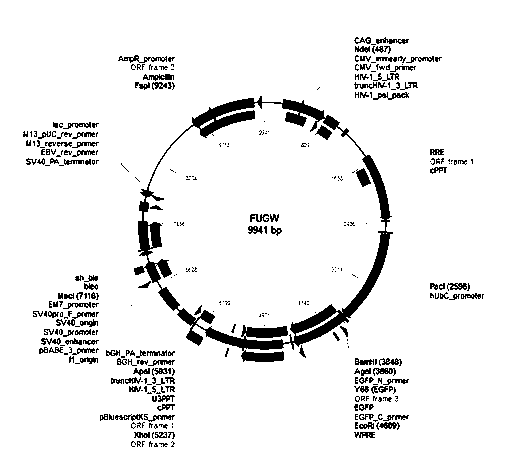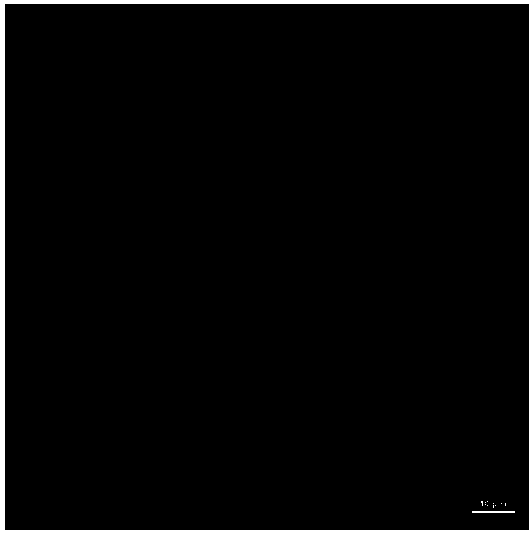Medicine composition for treating neuron degeneration disease
A composition and application technology, applied in drug combination, neurological diseases, gene therapy, etc., can solve the problems of long cycle, many steps, high failure rate, etc.
- Summary
- Abstract
- Description
- Claims
- Application Information
AI Technical Summary
Problems solved by technology
Method used
Image
Examples
Embodiment 1
[0114] Construction of Myt1L lentiviral vector:
[0115] (1) Using the cloned MYT1L cDNA as a template, carry out PCR reaction with amplification primers, and amplify to obtain a PCR product with a size of about 3.5 Kb.
[0116] (2) BamHI and AgeI double enzyme digestion is performed on the PCR product and the viral vector.
[0117] (3) T4 DNA ligase (purchased from Takara Company) was used to perform transformation reaction after ligation.
[0118] (4) Through the identification of transformants, positive clones were selected and sent for testing, and those whose sequencing sequence was consistent with the expected sequence were regarded as correct clones, and named as FUGW-MYT1L lentiviral vector.
[0119]
Embodiment 2
[0121] Packaging of Myt1L lentiviral vector:
[0122] (1) Prepare DNA solutions of three plasmids in the lentiviral packaging system (FUGW-MYT1L lentiviral vector 20 μg, pCMV-dR8.2 dvpr vector (purchased from Addgene) 15 μg, pCMV-VSV-G vector (purchased from Addgene) 10 μg, mixed with the corresponding volume of Opti-MEM and diluted evenly, adjusted the total volume to 2.5ml, and incubated at room temperature for 5 minutes.
[0123] (2) Take 100 μl of Lipofectamine2000 (purchased from invitrogen) reagent and mix and dilute it with 2.4 ml Opti-MEM (purchased from Invitrogen) in another tube, and incubate at room temperature for 5 minutes.
[0124] (3) Mix the diluted DNA described in (1) with the diluted Lipofectamine2000 described in (2), and mix by inverting gently within 5 minutes. Incubate at room temperature for 20 min.
[0125] (4) Transfer the mixture of DNA and Lipofectamine 2000 to the culture medium of 293T cells, mix well, and store at 37°C, 5% CO 2 cultured in ...
Embodiment 3
[0131] Myt1L lentivirus induced glial cells;
[0132] (1) When the glial cell U251 density reached 50%-60%, virus infection was carried out, and the cell culture medium was replaced with serum-free medium before infection.
[0133] (2) According to the MOI value of U251 cells (MOI=5), add an appropriate amount of MYT1L lentivirus (number of viruses added = number of cells x MOI value). Observe the cell state after 12 hours: if there is no obvious cytotoxic effect, replace the medium after continuing to culture for 24 hours; if there is obvious cytotoxic effect, replace the medium immediately.
[0134] (3) Medium replacement: Three days after U251 cells were infected with MYT1L lentivirus, the original medium was gradually replaced with Neurobasal medium (Invitrogen, 12348-017) containing factor N27 (Invitrogen, 17504-044,) . The replacement method is to keep 1 / 2 of the original medium each time, add 1 / 2 of the fresh Neurobasal medium with N27 factor, and replace the medium...
PUM
 Login to View More
Login to View More Abstract
Description
Claims
Application Information
 Login to View More
Login to View More - R&D Engineer
- R&D Manager
- IP Professional
- Industry Leading Data Capabilities
- Powerful AI technology
- Patent DNA Extraction
Browse by: Latest US Patents, China's latest patents, Technical Efficacy Thesaurus, Application Domain, Technology Topic, Popular Technical Reports.
© 2024 PatSnap. All rights reserved.Legal|Privacy policy|Modern Slavery Act Transparency Statement|Sitemap|About US| Contact US: help@patsnap.com










